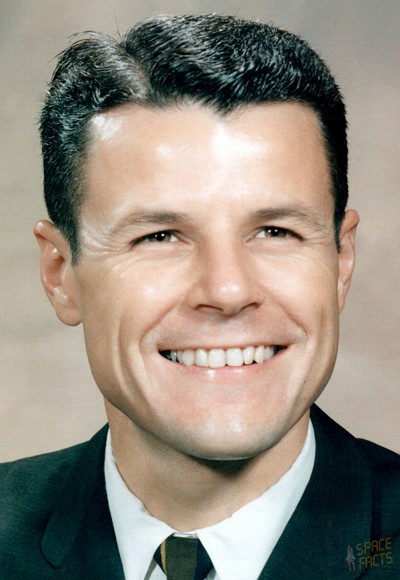Charles Bassett (Charles Arthur Bassett)

Bassett was born in Dayton, Ohio, on December 30, 1931. He was active in the Boy Scouts of America, where he achieved its second highest rank, Life Scout. After graduating from Berea High School in Berea, Ohio in 1950, he attended Ohio State University from 1950 to 1952, and Texas Technological College, now Texas Tech University, from 1958 to 1960. He received a Bachelor of Science degree in Electrical Engineering with honors from Texas Tech; he did graduate work at University of Southern California.
In 1952 he entered the United States Air Force as an Aviation Cadet. He trained at Stallings Air Force Base, North Carolina, Bryan Air Force Base, Texas, and Nellis Air Force Base, Nevada, completing advanced work in April 1954. He went to the Pacific with the 8th Fighter Bomber Group and was promoted to First Lieutenant in May 1955. He returned for pilot duties at Suffolk County Air Force Base, New York, serving until April 1958 when he took the Electrical Engineering course at the U.S. Air Force Institute of Technology at Wright-Patterson Air Force Base, Ohio. He graduated from the Aerospace Research Pilot School and the Air Force’s Experimental Test Pilot School and became a Captain in the U.S. Air Force. In November 1960 he went to Maxwell Air Force Base, Alabama, to attend Squadron Officer School and then he served as an experimental test pilot and engineering test pilot in the Fighter Projects Office at Edwards Air Force Base, California. He logged over 3,600 hours-flying time, including over 2,900 hours in a jet aircraft.
Bassett was one of the third group of astronauts named by NASA in October 1963. In addition to participating in the overall astronaut training program, he had specific responsibilities pertaining to training and simulators. On November 8, 1965, he was selected as pilot of the Gemini 9 mission with Elliot See as Command Pilot. According to chief astronaut Deke Slayton’s autobiography, he chose Bassett for Gemini 9 because he was “strong enough to carry” both himself and See. Slayton had also assigned Bassett as Command Module Pilot for the second backup Apollo crew, alongside Frank Borman and William Anders.
Bassett and See were killed on February 28, 1966, when their T-38 trainer jet, piloted by See, crashed into McDonnell Aircraft Building 101, known as the McDonnell Space Center, located 1,000 feet (300 m) from Lambert Field airport in St. Louis, Missouri. Building 101 was where the Gemini spacecraft was built, and they were going there to train for two weeks in a simulator. They died within 500 feet (150 m) of their spacecraft. Bassett’s death was particularly gruesome; he was decapitated in the impact and his head was later found wedged in the rafters. Both men were buried in Arlington National Cemetery. A NASA investigative panel later concluded that pilot error, caused by poor visibility due to bad weather, was the principal cause of the accident. The panel concluded that See was flying too low to the ground during his second approach, probably as a result of the poor visibility. Bassett was survived by his wife and two children.
Born
- December, 30, 1931
- USA
- Dayton, Ohio
Died
- February, 28, 1966
- USA
- St. Louis, Missouri
Cause of Death
- Killed in jet accident
Cemetery
- Arlington National Cemetery
- Arlington, Virginia
- USA


